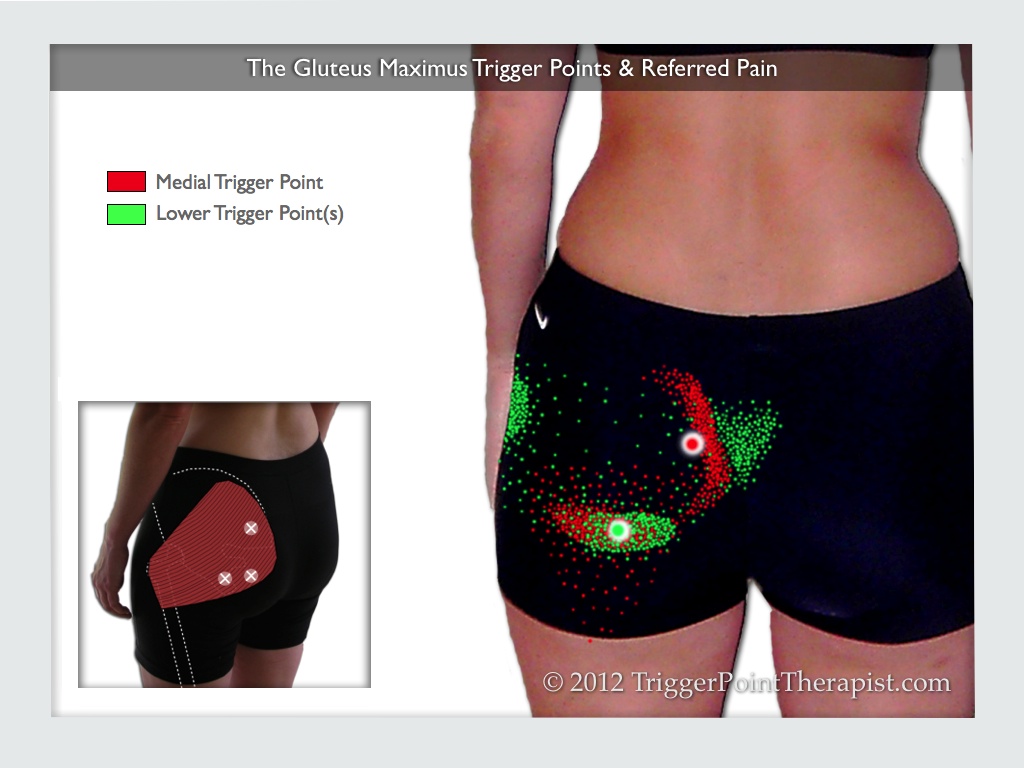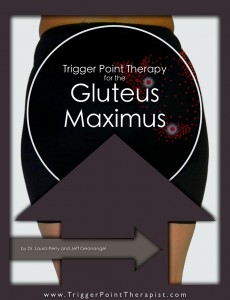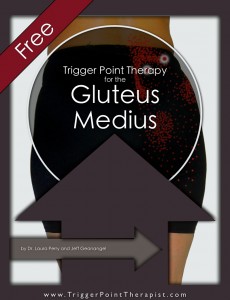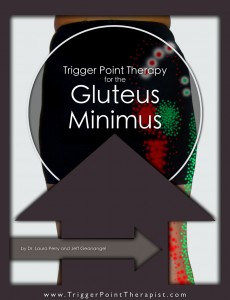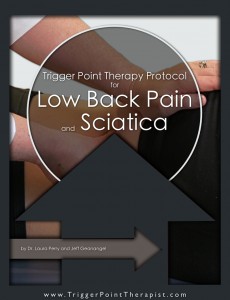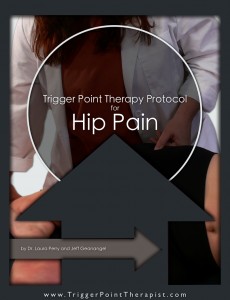As it’s name suggests, the gluteus maximus is the king of the gluteal muscles, and the ruler of gluteal pain. Many low back pain complaints involve a significant gluteal pain component, so the therapist needs to make a habit of addressing the gluteus maximus trigger points in every low back pain treatment plan.
Symptoms associated with gluteus maximus trigger points include gluteal pain and tenderness while seated, rising from a chair, sleeping, or walking up a slope or stairs. Pain may also be initiated by swimming or other sporting activities.
Clients may also complain of a sharp, stabbing pain in certain seated positions. Additionally, one of the trigger points in this muscle (though rarely seen in clinical practice) may produce pain and pressure sensations in the tailbone region.
The Gluteus Maximus Muscle
Anatomy & Biomechanics: The location of this muscle doesn’t need much explanation, as the gluteus maximus is the large muscle group that forms the buttocks.
This muscle group functions to enable and maintain the upright human posture. Electromyographic studies show this muscle to be most active while walking upstairs, walking uphill, jumping, running, squatting, and stooping forward.
With the leg free to move, contraction of the gluteus maximus muscles causes extension and lateral rotation of the thigh at the hip.Additionally, the gluteus maximus assists with abduction of the thigh at the hip.
The Gluteus Maximus Trigger Points
As shown in the diagram below, there are three potential trigger points in the gluteus maximus muscle:
- The medial trigger point is found adjacent to the lower sacrum, near the muscle’s medial attachment.
- There are two lower trigger points in this muscle, one that lies near the ischial tuberosity and one that lies on the inside edge of the gluteal fold region, below the tailbone or coccyx.
Gluteus Maximus Muscle Pain
The diagram above also shows the referred pain patterns associated with the gluteus maximus trigger points.
- The medial trigger point refers pain and tenderness locally in a crescent-shaped pattern across the buttock. The pain tends to concentrate along the edge of the sacrum and gluteal fold regions, but may extend down into the upper posterior thigh region as well.
- The lower trigger point refers pain across the entire buttock region, concentrating over the lower sacrum, ischial tuberosity, and lateral iliac crest regions. Deep tenderness in the buttocks is also associated with activity of this trigger point, and the client may also complain of a sharp, stabbing pain while sitting.
- The “tailbone” trigger point refers pain to the coccyx (tailbone) and anal region. Clients may complain of pressure on the coccyx while seated when this trigger point is active.
What Causes Gluteus Maximus Trigger Points?
The following events or activities may activate or reactivate the gluteus maximus trigger points:
- Muscle strain from a fall or from bracing to prevent a fall
- Impact from a fall
- Intramuscular injections
- Swimming (particularly the crawl stroke)
- Walking uphill while leaning forward
- Repetitive kicking, as with martial arts or dance.
- Weight lifting exercises, particularly squats and deadlifts.
- Prolonged sitting, especially with a slouched posture.
- Sleeping in a position that places the muscle in an elongated or shortened state.
- Sitting on a wallet
(For more information on the various causes of trigger points, please see What Causes Trigger Points.)
Gluteus Maximus Symptoms & Disorders
Clients with active gluteus maximus trigger points will present with any or all of the following symptoms or clinical findings:
- Gluteal pain and tenderness, especially while seated or walking up a slope or stairs
- Deep tenderness in the buttock region
- A sharp, stabbing pain while seated in a slouched position.
- Pain and pressure in the tailbone or anal region.
- Sacroiliac joint pain
- A restriction in hip flexion
Treatment of Gluteus Maximus Trigger Points
Release of the gluteus maximus trigger points is often required to make the muscle relax enough so that palpation of the underlying gluteus minimus trigger points is possible. Achieving an effective (long-lasting) release of these trigger points will often require that the therapist also address any trigger points in the hamstring, rectus femoris, and iliopsoas muscle groups.
For more information on the gluteus maximus trigger points, and for step-by-step instructions for releasing them, you can purchase the Trigger Point Therapy for the Gluteus Maximus Video Download or the Trigger Point Therapy for the Gluteus Maximus Booklet for the iPad.
Click on the image below to watch an excerpt from the Gluteus Maximus Trigger Points video on YouTube:
Related Articles:
- How to Release the Gluteus Medius Trigger Points (Video)
- Gluteus Minimus Trigger Points: A Small Muscle With A Big Mouth
- The Quadratus Lumborum Trigger Points: Masters of Low Back Pain
Related Instructional Videos:
